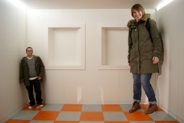cognition


cognition is ancient
In Unit 5, I showed how a single celled organism could have more than one way of acting that we observers could distinguish as “tranquil” or “distressed”. The internal process that enables the organism to thus appropriately respond is, cognition. Cognition refers to the entire complement of internal processes that enables a living system to shift its behaviour according so that it retains an appropriate connection with its niche.
Of course for more complex organisms with far larger repertoires and subtleties of behaviour, the whole cognitive process also become much more elaborated. A nervous system further expands cognitive possibilities.


image from What is Life?
Margulis and Sagan,1995
cognition consists of
sensory-effector coordination
Sometimes the process is referred to as sensory-motor coordination, which obscures some of the effectors, such as speech, of changes in emotioning, that are not generally considered to be “motor” responses.
living systems are cognitive systems
Living systems with nervous systems have a vastly expanded capacity for cognition. As these systems have evolved they have accreted what we can call different types of activities, or different domains of relations through the manner that they and their medium have co-evolved in structural coupling. Yet even with a vast repertoire with great finesse and richness, these cognitive responses depend on the circularity of sensory-effector relations and the accompanying changes in the niche. These circularities must have existed either in the evolutionary history of the organism (in what we name “innate” behaviours), or in more complex systems over the life time of the organism (in what we name as development or learning).
Though the various relational domains that we live are each lived as if separate (for example you don’t confuse your interactions with one person with those of another, and you don’t confuse what pertains to cooking dinner to the thoughts and actions that pertain to playing music) ... we don’t live a schizophrenic existence. Our experience feels continuous, and what we learn when doing one thing easily penetrates to how we act in some other domain. Our nervous systems, or better, our cognitive systems are systemic unities. I like to refer to some of the processes that enables integration between different domains of action as “structural intersection.” What I wish to capture with that phrase is that some of the same structures, for example nerve cells, are active in different domains of doings. As doings modify the cells, the modifications ripple through the whole system, maintaining our integrity as whole beings.

The synaptic contacts that the cell body receives from a motor neuron in the spinal medulla. Image from The Tree of Knowledge
Maturana and Varela, 1987
photo by silly little man
flickr creative commons
The image is of an “Ames Room” click on it to download section of the reading scheduled for Unit 10 that describes Ames’ experiments with perception.

